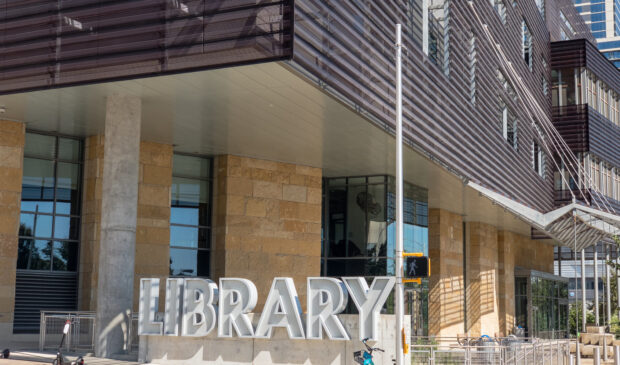New libraries, parks, health centers among facilities eyed for 2026 bond proposal
Thursday, May 1, 2025 by
Chad Swiatecki Up to four new libraries, more neighborhood health centers, and a host of new park properties and recreation centers are among the facilities being considered for the city’s next bond election that will likely take place in 2026. Representatives from three city departments presented their bond project goals and plans this week to the city’s Bond Election Advisory Task Force, which will play a major role in deciding the scope of the proposals expected to go before voters next fall.
The Austin Public Library is expected to seek funding to acquire land and begin design work for four regional branches, with an initial goal of constructing at least one of those facilities. The department is also proposing expansions at several existing branches and upgrades to ensure facilities can serve as warming and cooling centers.
These requests are part of the implementation phase of the Austin Public Library Comprehensive Strategic and Facilities Plan, which identified service gaps in areas that have grown beyond the reach of the current branch network in 2023.
Austin Public Health, which has received a small portion of funding from previous bond proposals, is preparing a request to fund more full-service neighborhood health centers, including one to expand STI treatment capacity. Funding for upgrades at the Women and Children’s Shelter and the renovation of existing public health buildings are also under consideration to help the department strengthen its resilience amid declining federal funds by shifting more support to the local level.
The Parks and Recreation Department is prioritizing land acquisition, facility reinvestment, and the development of new community and senior centers. Staff said new capital would target areas identified as parkland-deficient and expand access to high-demand recreational amenities. The department will also propose additional investments in regional trail infrastructure, including support for a segment of the planned 70-mile Lower Colorado River Trail network.
For the Library Department, the proposed new branches would likely be located in corners of the city not currently served by existing facilities. Library square footage per capita has declined since the 1980s as Austin’s population has increased and library services have expanded to include the city’s limited purpose and extraterritorial jurisdictions. The department noted that the last all-new branch location opened in 2004, with the Central Library opening downtown in 2017.
In addition to construction and land acquisition, the library’s request will include funding for major renovations and expansions of older branches to address the system’s space limitations for community programs, technology access, and emergency operations.
Task force members encouraged library staff to work with local schools and other related organizations to identify partnerships that could fill gaps in the community, suggesting APL could possibly use existing non-library properties to offer programming and services.
“I’ve met with many school superintendents across the state who are cutting back their library support services because they don’t have enough staffing to support them,” task force member Nicole Conley said. “I feel like there’s a potential opportunity here if we’re creative and thoughtful about the ability to optimize our schools as well as our city facilities around these ideas.”
Austin Public Health officials cited several recent bond-funded facilities, including the Dove Springs Health Center and the Montopolis Recreation and Public Health Center, as models for future development.
The department’s proposed new sites would extend services such as immunizations, maternal health programs, and food access assistance into additional neighborhoods. Staff emphasized that bond-funded projects are critical to transitioning the city away from reliance on episodic federal funding, which has recently been reduced.
“We are looking at ways to maximize how we can bring in additional revenues to support the center. And when the (political) climate changes, perhaps there’ll be opportunity for federal funding in the way that we’re used to,” Adrienne Sturrup, head of APH, said in reference to more participation in state programs and partnerships. “That is a good step in moving away from our over-reliance on federal funding and doing what we do best, taking care of Austinites right here at home.”
To prioritize projects, Austin Public Health is using a technical criteria scoring system that incorporates factors such as inclusive facility design, preventive health planning, and sustainability. The department’s goal is to ensure new facilities are accessible, community-centered, and capable of supporting multiple services in a single location.
The Parks and Recreation Department shared similar concerns about meeting growing demand with limited resources. From the $215.5 million allocated in the 2018 bond, the department reported that 81 percent has been either spent or encumbered, with remaining funds reserved for contingency and already-assigned projects.
Future parks bond requests are expected to emphasize equity, with funding directed toward parkland acquisitions, recreation center expansions, and new facilities in fast-growing parts of the city. City staff is also weighing proposals to partner with other departments or public entities, such as schools, to co-locate services and optimize land use.
Photo made available through a Creative Commons License.
The Austin Monitor’s work is made possible by donations from the community. Though our reporting covers donors from time to time, we are careful to keep business and editorial efforts separate while maintaining transparency. A complete list of donors is available here, and our code of ethics is explained here.
You're a community leader
And we’re honored you look to us for serious, in-depth news. You know a strong community needs local and dedicated watchdog reporting. We’re here for you and that won’t change. Now will you take the powerful next step and support our nonprofit news organization?





